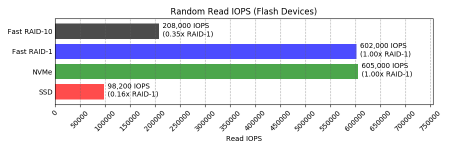Background ^
In the previous article, “Linux RAID-10 may not always be the best performer, but I don’t know why“, we discovered that a RAID-10 of two mismatched drives can perform 3 times worse at random reads than a RAID-1 of the same devices.
In my case the two devices were a Samsung PM983 NVMe and a Samsung SM883 SATA SSD. The NVMe is about 6 times faster than the SSD at random reads.
An explanation ^
I posted about my findings on the linux-raid mailing list and got a very helpful reply from Guoqing Jiang.
It seems that RAID-1 has an enhancement for non-rotational devices such that it will direct IO to the least-loaded device.
For rotational devices, the distance between the location of the sectors is more important than which device is least loaded, because switching spindles has a big penalty in seeking to the correct location.
This is not so for non-rotational devices like SSD and NVMe, so if a non-rotational and lightly loaded device is available, it is selected for IO. That is why with RAID-1 I saw most of the IOs going to the fast NVME device with a corresponding boost in performance compared to RAID-10.

The same enhancement has not been made for RAID-10. I do not know if this is just because no one got around to it yet, or if it’s because it may be technically harder (or impossible).